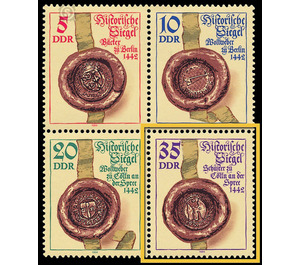Commemorative stamp series - Germany / German Democratic Republic 1984 - 35 Pfennig
Theme: Post & Philately
| Country | Germany / German Democratic Republic |
| Issue Date | 1984 |
| Face Value | 35.00 |
| Color | brown |
| Perforation | K 14 |
| Printing Type | offset |
| Stamp Type | Postage stamp |
| Item Type | Stamp |
| Chronological Issue Number | 2629 |
| Chronological Chapter | GER-DDR |
| SID | 281546 |
| In 19 Wishlists | |
Historical seals With the illustrations of historical seals, the Ministry of Posts and Telecommunications of the German Democratic Republic issues four multi-colored special postage stamps in combination. Special cancellation from 7th August to 6th October 1984 Historical seals Medieval seals, as they were used for the certification of documents, are not only considerable artistic evidence, but also sources of historical knowledge. This applies to the seals of the secular and religious feudal lords as well as to the seals of the councils and the corporations of the early bourgeoisie, confronting them in class struggles with each other and among themselves. Like the merchants in charge of the city council, since the thirteenth century craftsmen had also been incorporated into corporations, the organization of labor, social welfare and religious-religious fellowship among the members, the political representation of their interests, and the military defense of the city served. The guilds also adopted field signs and legal plates. The seals of the guilds, never before handed down in the German Reich before 1300, first show the symbols of their patron saints (church saints, altar foundations) and their meeting places (churches, chapels), but soon also raw materials, products and tools of their craft activity. Berlin and its sister city Cölln an der Spree, which first appeared in written sources in 1244 and 1237 respectively, developed into an economic and political center of the Mark Brandenburg. Berlin became the suburb of the Central German city union and member of the Hanseatic League. In 1346, the four most important guilds (cloth makers, cobblers, butchers, bakers) succeeded in Berlin and Cölln to end the autocracy of the patriciate and to participate as four-movements in the council business. When, one hundred years later, urban tensions arose again, the Elector of Brandenburg took advantage of this to break the autonomy of these two cities and to integrate them into the emerging territorial state. Advocates and guilds sealed the subjugation on August 29, 1442 with a document, which is now kept in the State Archives Potsdam. Among the eight seals of the four movements of Berlin and Cölln attached with parchment strips (pressings) to this document, two were selected for the emission. The imprints are on dark brown wax, which is embedded in slightly lighter wax bowls from 50 to 60 mm in diameter. 35 Pfennig value: cobbler to Cölln on the Spree The shoemaker (sutores) to Cölln had to prepare their own leather. In her seal (34 mm diameter) are on a round tendril-decorated field heraldic right a last for a gothic fashion corresponding shoe, on the left an upright hatchet for leather processing, above a cross. The inscription reads "S (IGLLVM) VNIONIS: AC: GVLDE: SVTORV (M) I (N) COLE (N)". The four seals could be made by the same engraver. All legends show the same writing, unziale upper case with Gothic jewelry in the form of triangular points. Due to the stylistic features and historical comparisons, the seal stamps for the coins, which were handed down in 1442, probably date back to around 1330.


